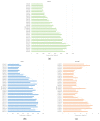Main Challenges Expected from the Impact of Climate Change on Microbial Biodiversity of Table Olives: Current Status and Trends
- PMID: 37835365
- PMCID: PMC10572816
- DOI: 10.3390/foods12193712
Main Challenges Expected from the Impact of Climate Change on Microbial Biodiversity of Table Olives: Current Status and Trends
Abstract
Climate change is a global emergency that is affecting agriculture in Mediterranean countries, notably the production and the characteristics of the final products. This is the case of olive cultivars, a source of olive oil and table olives. Table olives are the most important fermented vegetables in the Mediterranean area, whose world production exceeds 3 million tons/year. Lactic acid bacteria and yeast are the main microorganisms responsible for the fermentation of this product. The microbial diversity and population dynamics during the fermentation process are influenced by several factors, such as the content of sugars and phenols, all of which together influence the quality and safety of the table olives. The composition of fruits is in turn influenced by environmental conditions, such as rainfall, temperature, radiation, and the concentration of minerals in the soil, among others. In this review, we discuss the effect of climate change on the microbial diversity of table olives, with special emphasis on Spanish and Portuguese cultivars. The alterations expected to occur in climate change scenario(s) include changes in the microbial populations, their succession, diversity, and growth kinetics, which may impact the safety and quality of the table olives. Mitigation and adaptation measures are proposed to safeguard the authenticity and sensorial features of this valuable fermented food while ensuring food safety requirements.
Keywords: climate change; mitigation measures; safety; spoilage; table olives.
Conflict of interest statement
The authors declare no conflict of interest.
Figures





References
-
- IPCC AR6 Synthesis Report: Climate Change 2023. [(accessed on 1 September 2023)]. Available online: https://www.ipcc.ch/report/sixth-assessment-report-cycle/
-
- WWF Report Wildlife in a Warming World. [(accessed on 1 September 2023)]. Available online: https://wwfint.awsassets.panda.org/downloads/FOCUS_Mediterranean_1403201....
-
- IUCN Invasive Alien Species and Climate Change. [(accessed on 1 September 2023)]. Available online: https://www.iucn.org/resources/issues-brief/invasive-alien-species-and-c....
-
- European Parliament Climate Change in Europe: Facts and Figures. [(accessed on 1 September 2023)]. Available online: https://www.europarl.europa.eu/news/en/headlines/society/20180703STO0712....
-
- NASA Earth Observatory Drought on the Iberian Peninsula. [(accessed on 1 September 2023)]; Available online: https://earthobservatory.nasa.gov/images/14719/drought-on-the-iberian-pe....
Publication types
Grants and funding
LinkOut - more resources
Full Text Sources

